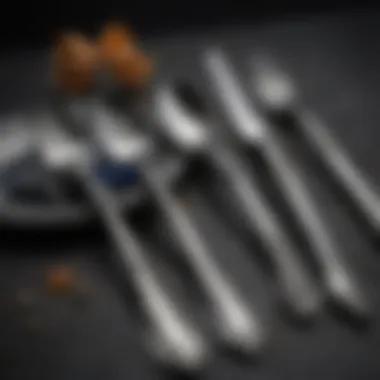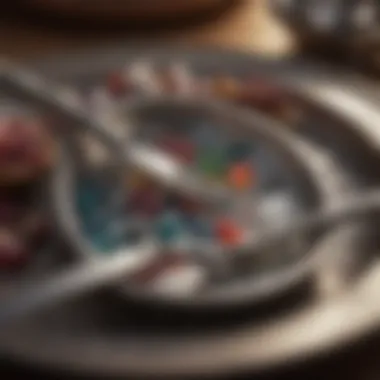The Best Cleaners for Your Silverware: A Complete Guide


Intro
Maintaining silverware isn’t just about keeping up with appearances. It’s about preserving a piece of history, as silver items often carry stories from generations past. Silver tarnish is a common bane for owners, turning beautiful pieces into dull reflections of their former selves. A deep understanding of how to clean and care for silverware is key to upholding its aesthetic appeal and functionality.
Silver tarnish occurs due to a reaction between silver and sulfur compounds in the air. The darkening of silver creates a stark contrast with its natural shine, prompting many to seek effective cleaning solutions. In this article, we’ll dig into a variety of methods that can help bring the gleam back into your silver.
From commercial products to tried-and-true homemade cleaner recipes, we’ll cover ample ground on what really works. Plus, we’ll navigate the essential safety considerations and best practices for the storage and care of your silver items. By the end, you’ll have a well-rounded toolkit to ensure your silverware not only looks its best but lasts for years to come.
So, whether you’re hosting a formal dinner or simply enjoying a cozy meal at home, knowing how to keep your silver shining can elevate your dining experience.
Prolusion to Silverware Care
Taking care of silverware is not merely a chore but an essential practice that preserves both the beauty and value of these items. Silverware often holds sentimental value, passed down through generations or gifted on special occasions. Maintaining these pieces ensures they remain as beautiful as the day they were received, enhancing their aesthetic appeal and functional integrity. This section will delve into the importance of understanding the nuances of silverware care and how effective cleaning techniques can prolong the life of your treasured items.
Understanding Silver and Its Properties
Silver is a metal that has been used for centuries, adored not only for its beauty but also for its utility. Its properties include malleability, durability, and excellent thermal conductivity, making it a favorite for crafting everything from intricate jewelry to elegant tableware. Silver's natural luster is what gives it that classic shine, but this characteristic also makes it susceptible to tarnish.
At the atomic level, silver has an electron configuration that allows it to easily lose electrons when exposed to certain environmental factors. This leads to the formation of silver sulfide, commonly known as tarnish. Understanding these properties is crucial for anyone aiming to care for silverware effectively. Recognizing that tarnish is a direct consequence of silver's reaction with sulfur compounds—often found in everyday items like rubber bands, wool fabrics, and some foods—is the first step towards prevention and maintenance.
Importance of Silverware Maintenance
The maintenance of silverware involves regular cleaning and proper storage, both of which are vital for keeping that attractive gleam alive. Ignoring these practices can lead to a range of issues:
- Tarnishing: As previously mentioned, tarnish can diminish the visual appeal of silverware.
- Pitting: Prolonged exposure to tarnish can lead to surface damage, resulting in pitting, which diminishes the value of the piece.
- Hygienic Concerns: Particularly for cutlery, inadequate cleaning can harbor bacteria and residues, posing health risks.
Incorporating a systematic maintenance routine is essential. Regularly assessing your silverware for signs of tarnish and applying effective cleaning techniques can make a substantial difference.
"Taking a proactive approach to silverware care will not only enhance its appearance but will also ensure that these cherished items can be enjoyed for years to come.”
Understanding silver and maintaining its brilliance is an investment in preserving the legacy carried in these beloved pieces. Learning effective cleaning methods will be the focus of the next sections, equipping you with the knowledge to care for your silverware adeptly.
The Science of Tarnish
Understanding tarnish is crucial for anyone looking to maintain the beauty and function of silverware. Tarnish is more than just an unsightly layer; it involves a complex interplay of chemical reactions and environmental conditions. This section delves into those interactions, providing the knowledge necessary to combat tarnishing effectively.
Chemical Reactions Leading to Tarnish
Tarnish on silver is primarily the result of a chemical reaction between silver and sulfur-containing substances in the environment. When silver is exposed to air, it reacts with hydrogen sulfide, which is commonly found in trace amounts in the air and certain foods. Over time, this reaction produces silver sulfide, a dark compound that manifests as tarnish.
- This process can be likened to oxidation, where silver forms a new compound that drastically alters its appearance.
- Another contributing factor includes moisture, which accelerates these reactions. When humidity levels rise, the risk of tarnishing increases significantly.
- Other environmental chemicals, such as those released by rubber or even some fabrics, can leave surprising residues that trigger these reactions.
Tarnish may start as a thin film, but left untreated, it can lead to deeper corrosion. Understanding these reactions empowers silverware owners to be proactive, implementing timely cleaning practices.
Environmental Factors That Contribute to Tarnish


Many elements in our surroundings can exacerbate tarnishing. Among them is air quality. High pollution levels contain sulfur compounds, significantly raising the likelihood of tarnishing.
- In urban environments, the problem is often more acute. The presence of smoke, exhaust fumes, and industrial emissions creates a cocktail that silver cannot escape.
- Additionally, metal objects stored nearby can also transfer chemicals, inadvertently causing tarnish.
Humidity and temperature fluctuations play a significant role in tarnishing as well. Here are a few environmental aspects to consider:
- Moisture: Areas prone to humidity or dampness increase tarnishing risks. Silver should ideally be kept in a cool, dry environment.
- Pollution: Cities with high air pollution expose silverware to more harmful agents. It’s smart to avoid displaying silverware in open areas where exposure is constant.
- Storage conditions: Improper storage can trap moisture and air, creating a breeding ground for tarnish.
In summary, recognizing the combination of chemical reactions and environmental factors that contribute to tarnish can significantly enhance one’s approach to maintenance. By taking preventive steps, silverware owners can keep their collections shining brightly for years to come.
Remember, the first line of defense against tarnish is understanding its causes. Knowledge is your best ally in silverware care.
Commercial Cleaning Products for Silverware
When it comes to keeping silverware in top shape, commercial cleaning products often take center stage. Their relevance lies in their specialized formulation, which is designed to break down tarnish while preserving the delicate shine of silver. For many, the convenience of having a readily available solution cannot be understated. These pre-packaged formulas save time and effort, especially for those who may not have the time or inclination to whip up DIY solutions.
Types of Silver Cleaners Available
The market is flooded with various cleaning products tailored for silverware, and knowing which to choose can be a bit like finding a needle in a haystack. Here are some popular types:
- Liquid Silver Cleaners: These are a favorite because they allow for quick application. Typically, you just dip your silverware into the solution and rinse it off afterward.
- Polishing Cloths: Infused with cleaning agents, these cloths are practical and great for a quick touch-up. Simply rub your silverware with the cloth to restore its shine.
- Paste Cleaners: While a bit more labor-intensive, these pastes are effective against stubborn tarnish. Apply, let sit, and then wipe off for a pristine finish.
- Tarnish Remover Sprays: These are aerosol options that provide a spray-on convenience but often necessitate a wipe-down afterward.
Each type offers unique advantages and can be chosen based on specific needs, ranging from heavy-duty cleaning to quick maintenance.
Assessing Effectiveness and Safety
It's one thing to buy a cleaner, but it's another to understand its effectiveness and safety. Many consumers prefer products that deliver results without causing harm. Here’s what to consider:
- Ingredients: Always check the label to identify active ingredients. Some cleaners contain chemicals that may be too harsh for certain types of silver or even unsafe for occasional use.
- User Reviews: Exploring feedback from fellow users can offer insight into a product's effectiveness. Online platforms like Reddit can serve as effective forums for discussions on specific products.
- Safety Precautions: Some cleaners may emit strong fumes or might require gloves during application. It’s wise to follow all recommended safety practices to avoid any mishaps.
"A cleaner that works effectively is of no use if it compromises your health or the integrity of your silverware."
Cost Considerations and Value for Money
Budgeting for silverware cleaning might seem trivial, but considering the cost vs. value is key. Higher price tags often indicate a product with superior formulation or concentrated ingredients. Factors to take into account include:
- Gallon vs. Standard Size: Sometimes, buying in bulk offers better savings if you have a lot of silver to clean.
- Effectiveness vs. Cost: A cheaper cleaner might save money upfront but could require you to use more product to achieve desirable results, making it less economical in the long run.
- Sustainability: Some options are eco-friendly, which may cost more but could save you from ending up with unwanted chemicals in your household.
Ultimately, finding the right silver cleaner involves balancing budget, effectiveness, and environmental impacts, ensuring you choose a product that respects both your silverware and the planet.
DIY Silverware Cleaning Solutions
Embarking on the journey of maintaining silverware often leads enthusiasts to consider the merits of do-it-yourself (DIY) cleaning solutions. These approaches offer several benefits that set them apart from commercial alternatives. For starters, DIY solutions can be significantly more cost-effective. Many households already harbor the necessary ingredients, reducing additional spending on specialized products. Such methods also empower users to customize their cleaning process, allowing for adjustments based on individual preferences.
Additionally, a homemade cleaner can eliminate the concern over harsh chemicals often found in commercial products. For those conscious about safety, especially in the presence of children or pets, this can be a crucial factor.
Furthermore, utilizing common household ingredients promotes a sustainable lifestyle, minimizing waste and the carbon footprint associated with manufacturing and shipping commercial cleaners. In this part of the article, we will delve into some effective DIY solutions for keeping your silverware gleaming.


Common Household Ingredients for Cleaners
Several household items can do wonders for tarnished silverware. Here are a few that might already be sitting in your kitchen:
- Baking Soda: A versatile product, baking soda acts as a mild abrasive that can lift tarnish without scratching the silver surface.
- White Vinegar: Known for its acidic properties, white vinegar helps dissolve tarnish while also imparting shine.
- Salt: When combined with other ingredients, salt serves as an effective cleaner due to its grit and chemical reaction with silver tarnish.
- Lemon Juice: This citrus fruit not only smells delightful but its natural acidity helps break down tarnish.
- Olive Oil: While it may seem counterintuitive, a small amount of olive oil, when mixed with other ingredients, can provide a beautiful luster to your silver pieces.
By combining these ingredients in various concoctions, you can create an effective and gentle cleaning agent for silverware.
Step-by-Step Instructions for Effective Cleaning
To successfully clean your silverware using DIY methods, follow this easy guide:
- Prepare Your Cleanser: Combine a tablespoon each of baking soda, salt, and white vinegar with water in a bowl. If you prefer a paste-like consistency, adjust the water accordingly.
- Soak the Silverware: Submerge the tarnished items in the mixture and let them sit for about 10–15 minutes. The solution works on loosening tarnish and grime.
- Gently Scrub: Take a soft cloth or sponge and gently rub the silverware. Pay special attention to intricate designs where tarnish may hide.
- Rinse Thoroughly: Once you notice a noticeable change, rinse the silverware under cool water to remove any residual cleaner.
- Dry Off: Finally, pat the pieces dry with a lint-free cloth. This helps prevent water spots, ensuring your silverware shines bright!
Tips to Enhance Cleaning Results
For optimal results, consider these suggestions:
- Test on a Small Area: Especially important for antique or valuable pieces, testing on a less visible area can prevent damage.
- Frequency of Cleaning: For silverware that is used regularly, cleansing every few months should suffice. For items lying dormant, check once a month for signs of tarnish.
- Stay Gentle: Avoid abrasive scrubbers as they can scratch the surface. Soft cloths are preferable.
"An ounce of prevention is worth a pound of cure." This old saying rings true when thinking about your silverware.
Whether you're an avid collector or simply looking to maintain a cherished family heirloom, DIY cleaning solutions can be both effective and enjoyable to execute. Embrace the power of simple ingredients and give your silverware the care it deserves.
Preventative Measures for Silverware Maintenance
Maintaining silverware isn't just about cleaning; it's about establishing a regimen that ensures your pieces retain their beauty and functionality over time. Many folks underestimate the power of prevention. With the right approaches, tarnishing can be significantly delayed, and the need for intensive cleaning diminished. By adopting the right storage techniques, establishing maintenance routines, and utilizing anti-tarnish products, one can safeguard their silver treasures effectively. Let's delve into each of these strategies, illuminating their benefits and simplicity.
Proper Storage Techniques
Storing silverware might seem straightforward, but the manner in which these items are kept can have a profound impact on their longevity. When silver is left exposed to air, humidity, and other environmental elements, it’s like leaving a door wide open for tarnish to slip in.
Here are some key tips for effective storage:
- Use tarnish-resistant cloths: Lining drawers with this fabric can ward off tarnish for months. It's like wrapping your silver in a protective shield.
- Keep in a cool, dry place: A climate-controlled environment is ideal. Look for places away from kitchen heat and humidity. Think of it like tucking your silver away for a cozy rest.
- Avoid plastic: Some plastics release harmful chemicals that can harm silver. Instead, opt for cloth or wooden storage solutions. Keeping it natural can do wonders.
By focusing on these storage techniques, you create a conducive environment for your silverware to remain shiny and tarnish-free, maximizing their lifespan.
Regular Maintenance Routines
Even the most careful handling won't prevent tarnish entirely, thus establishing a maintenance routine is vital. A little effort can go a long way. Not only does this practice keep silverware in prime condition, but it also allows for minor issues to be addressed before they develop into more significant problems.
Consider including these into regular routine:
- Routine polishing: A light polish every couple of months can prevent tarnish from building up. There’s no need to go overboard—just a gentle rub with a soft cloth can make all the difference.
- Check for tarnish: Regularly inspect your silverware for any signs of tarnishing. Spotting early signs can lead to easier cleaning strategies later on. It’s like checking for leaks before they turn into a flood.
- Use your silverware: Don't just store your silver—use it! Frequent use can naturally reduce tarnish buildup, keeping the pieces lively and cherished.


By incorporating these simple steps into your routine, you can prolong the gleam of your silverware while making it a part of cherished occasions.
Use of Anti-Tarnish Products
In today's market, a wide range of anti-tarnish products is available, each promising to give your silverware that extra edge against tarnishing. However, choosing the right products and using them effectively is crucial.
Consider these common options:
- Anti-tarnish cloths: These are pre-treated with special chemicals. Utilizing such cloths during polishing can provide a protective layer against tarnishing.
- Storage solutions: Many stores offer bags and boxes infused with anti-tarnish chemicals. These can be particularly handy for long-term storage. Think of it as a cozy, protective bubble for your treasures.
- Sprays and dips: There are also sprays that can be used after cleaning, forming a protective coat. It’s akin to putting on sunscreen before heading out into the sun.
While using these products, always follow the manufacturer’s instructions for maximum effectiveness. With proper application, anti-tarnish products can significantly extend the life and shine of your silverware.
"An ounce of prevention is worth a pound of cure."
Maintaining silverware is about taking proactive measures that save time and effort down the road. The strategies discussed here—thoughtful storage, regular maintenance, and effective anti-tarnish products—are essential in nurturing your silverware's aesthetics and functional value.
Common Mistakes in Silverware Cleaning
Understanding common mistakes in silverware cleaning is crucial for anyone who values the aesthetic and functional integrity of their silver pieces. By identifying and avoiding these pitfalls, you can uphold the beauty and longevity of your silverware, ensuring its glimmer remains intact for generations. The significance of this section lies in raising awareness about practices that may seem trivial yet have substantial consequences in terms of tarnish, damage, and overall wear.
Avoiding Abrasive Materials
When cleaning silverware, it is imperative to avoid abrasive materials such as harsh scrubbing pads, steel wool, or even certain cleaning agents that may contain gritty components. These materials can scratch the surface of silver, leaving behind fine scratches that not only dull the shine but can also collect tarnish more easily over time. Instead, opt for soft cloths or specialized silver cleaning cloths made specifically for this task. The gentler the touch, the longer your silver items will maintain their pristine luster.
Remember, your silverware deserves tender love and care. A gentle approach pays dividends in the form of lasting beauty.
In addition to choosing the right cleaning tools, it's vital to handle each piece carefully during the cleaning process. Silverware often has delicate patterns or engravings that can be easily damaged. Always start by rinsing items in warm water to remove any loose debris—this prevents scratching during the actual cleaning process.
Chemicals to Steer Clear Of
Not all cleaning agents are created equal, especially when it comes to silver. Certain chemicals can react negatively with silver, leading to damage that may be irreparable. Here are several common culprits to avoid:
- Chlorine: Found often in bleach, this substance is known to tarnish and corrode silver.
- Strong acids: Items like vinegar may have their uses in some DIY cleaning contexts, but can be harmful to silver due to their acidic nature.
- Ammonia: While it might effectively clean other surfaces, ammonia can cause tarnish on silver at an accelerated rate.
It’s wise to read labels thoroughly before employing a product on your silverware. Even if a cleaner is marketed as suitable for metals, it’s helpful to research its specific properties regarding silver. Many silver enthusiasts and collectors have found themselves disheartened after using the wrong cleaner and discovering the unsightly aftermath.
Closure
The conclusion of this article serves as a pivotal gathering point, summarizing the cornerstone strategies and insights necessary for silverware care. As we've explored, effective cleaning of silverware isn't just about restoring its shine; it's about preserving the value and integrity of cherished items. Understanding the various methods—be it commercial products or DIY solutions—ensures that one doesn't simply clean but also protects these valuable pieces from the detrimental effects of tarnish.
Recap of Best Practices for Silverware Care
Reflecting on our journey through silverware maintenance, it is clear that a multi-faceted approach yields the best results. Here are the tried-and-true strategies:
- Regular Cleaning: Make a habit of cleaning your silverware often with suitable cleaners to prevent heavy tarnishing.
- Avoid Abrasive Cleaners: Use non-abrasive materials to avoid scratching and damaging the silver surface.
- Store Properly: Keep silverware in a dry, cool place, ideally in anti-tarnish wraps or cloths, to minimize exposure to air and moisture.
- Utilize Anti-Tarnish Products: Consider using polish or special storage solutions that are designed to combat tarnish over time.
These practices not only help in maintaining the aesthetic appeal of your silverware but also extend their lifespan, ensuring they can be treasured for generations.
Encouraging a Mindful Approach to Maintenance
A mindful approach to silverware maintenance can truly transform the experience from a mere chore into an enjoyable ritual. Taking time to understand each piece—its history, its unique finishes, and its cleaning needs—can deepen your appreciation for your collection.
- Engage with Your Collection: Regularly inspect your silverware. This not only helps in early tarnish detection but also reinvigorates your connection to the items.
- Take Notes: Keep a log of what cleaning methods work best for different pieces. This helps in creating a tailored maintenance schedule.
- Educate Yourself: Learn previously unknown details, like how temperature changes can affect tarnish. Knowledge is power when it comes to preserving your silverware.
By treating silverware care with mindfulness and intention, it becomes less of a task and more a personal journey toward preserving artful history in your home.







